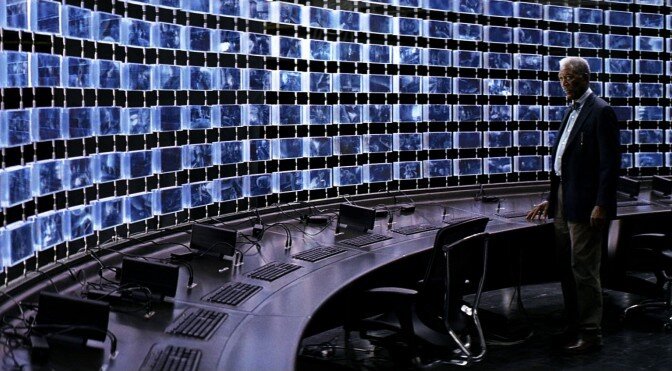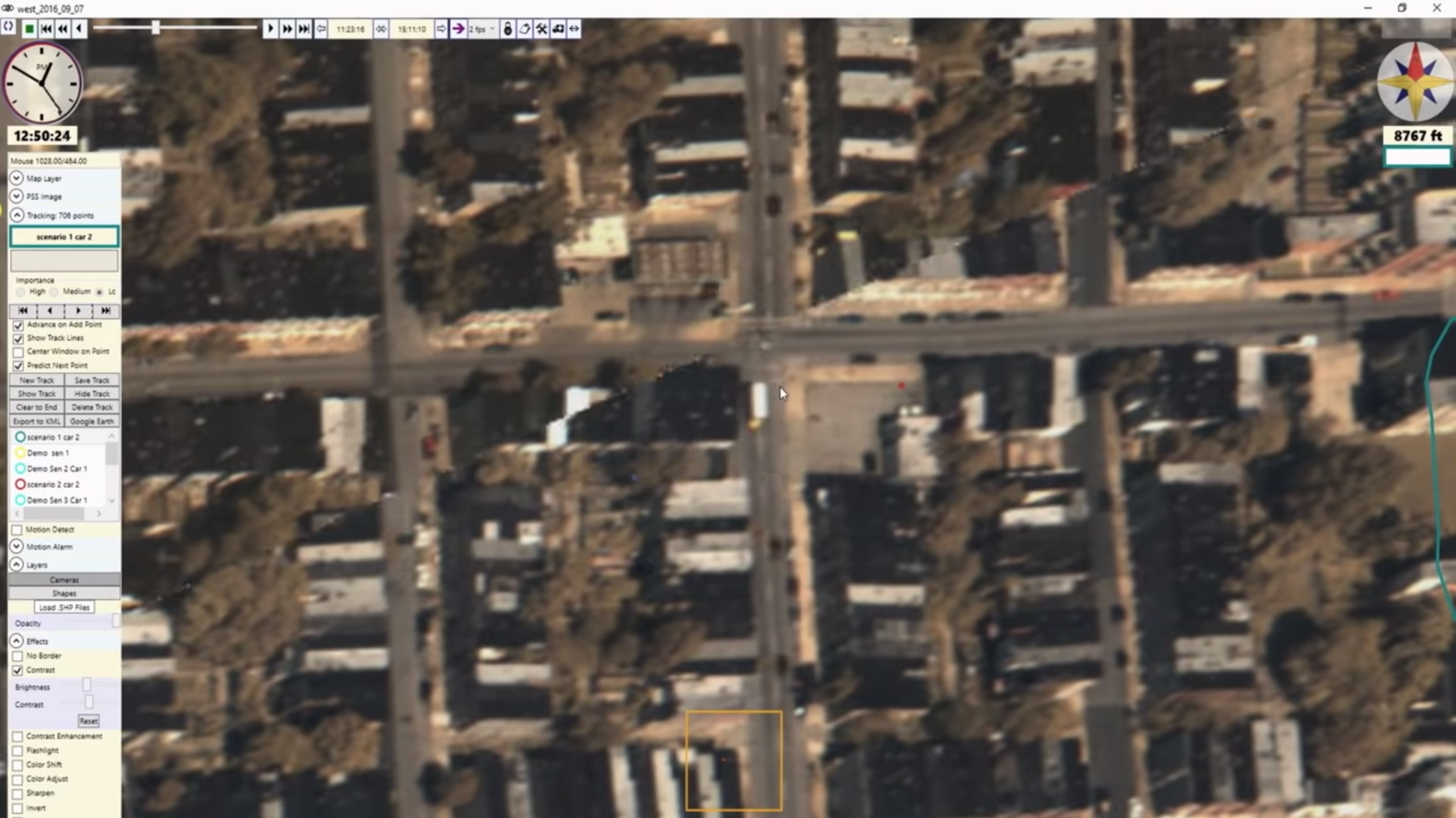Review by Andrew Swafford
“The camera doesn’t take sides; it’s the all-seeing eye.”
– a Baltimore police officer, leading a bodycam training in All Light, Everywhere
My name is Andrew Swafford. I’m a 29-year-old white dude; I do podcasting, review editing, and occasional writing for the film website you’re reading now; I make my living by teaching high-school English in the southern United States. In the county where I teach, a 17-year old black student was recently shot and killed at school by a white police officer who faced no legal repercussions. I thought about that a lot while watching All Light, Everywhere, the new film from Baltimore documentarian Theo Anthony.
A work of film criticism, as a general rule, tends to assume the posture of an objective observer: the job is to describe the film as accurately as possible, to get the reader to see the film for what the critic believes it is. Passing judgement on the film’s goodness or badness only comes after breaking the film down into its component parts and assessing whether and how those parts work. All Light, Everywhere, however, resists this approach, as it’s a film about objectivity itself being elusive and perhaps unattainable – and it’s in this spirit that I’ve chosen to open my review of the film with a few brief facts about myself and the context within which I’ve experienced it. There’s always at least one layer of human bias skewing our perspective, Anthony argues, even when that perspective is mediated by inhuman technology. There’s always something outside the frame.
All Light, Everywhere is a fragmented and free-associative documentary about many things, but it is primarily about cameras. Archival vignettes about early camera technologies and their often-nefarious inventors serve as connective tissue for Anthony’s own footage regarding surveillance cameras used by police. Three main narrative strands are weaved throughout the film: first, there’s a guided tour through Axon, the company formerly known as Taser, where the vast majority of police bodycams are now designed and manufactured; secondly, there’s an instructional workshop in which Baltimore city police are trained in the use of Axon bodycams; and finally, there’s a series of conversations with a man working for Aerial Investigations Research (AIR), a program (recently deemed unconstitutional and shut down by a Federal court) designed to constantly surveil the entirety of Baltimore using a set of drones capturing and recording a live birds-eye-view feed of the city.
Much of this footage, in another documentary, might be described as “fly-on-the wall,” as very little commentary is provided by Anthony while these surveillance systems are explained and proselytized for at length. Theo Anthony, however, seems to believe that the truth-value often ascribed to “fly-on-the-wall” documentaries (such as those by Fredrick Wiseman) is overstated. Anthony offers frequent reminders of his own presence behind the camera: we see him coaching certain speakers on where to stand and how to move for a given shot, we see him experimenting with cameras that get used elsewhere in the film, we see his reflection in glass as his camera glides through the Axon factory, and we even see him scrubbing around the video software he used to piece together All Light, Everywhere. Many of these interjections encourage the audience to confront the observer effect in action: just the mere presence of a camera impacts the behavior of the subject being filmed. And indeed, many of subjects make offhand remarks about how certain interactions and altercations captured by Anthony might have played out differently if his camera wasn’t present.
Theo Anthony’s central thesis here seems to be that while cameras are often thought of as tools to capture or document objective reality – to show the truth – they are always only capturing subjective versions of the truth. Consider: Who is taking the video? What are they choosing to shoot? What are they choosing to ignore or splice out? What is this footage being used for? How did the presence of the camera or the person holding it influence the actions captured on screen? All of these are questions that go unanswered when we accept a piece of video footage as simply a flat reflection of reality. And leaving those questions unanswered tends to only benefit those already in power: not those being surveilled, but those doing the surveillance.
Throughout All Light, Everywhere, Anthony takes his home city of Baltimore as a case study in large-scale surveillance. Some of the most chilling footage in the film is that captured by AIR, looking down upon the entire city through a sinister haze of pixelation as the various drone feeds push and pull against one another like overlapping radar screens. It looks uncannily similar to the technologies dreamt about in Tony Scott’s Déjà Vu and Christopher Nolan’s The Dark Knight, only more upsetting for being all too real. In 2015, AIR’s live feed of the city was used by police in the aftermath of the police-killing of Freddie Gray to identify where protests were beginning to form in order to forcefully crack down on them – all without the Baltimore Mayor even having knowledge that this program existed. The program’s stated purpose was to deter future crimes by making them very difficult to hide, but even assuming the need for such a technology creates inequity: if the state grants itself godlike powers of surveillance to look for crime in Baltimore, they’ll find it. Where is crime going unnoticed because of the assumed innocence of its location? Who gets surveilled, and why?
Déjà Vu (2006)
The Dark Knight (2008)
All Light, Everywhere (2021)
At one point, the AIR spokesperson Anthony has been interviewing holds a town-hall meeting at a community center where a heated and fascinating argument ends up breaking out. During the discussion, Theo Anthony wisely points his camera at other cameras positioned throughout the room: those in the hands of black citizens wishing to document the words and affect of this enterprising white man coming into their neighborhood and explaining why he needs to watch their every move. It’s a powerful reversal of the ideas that the film has been exploring all along. Cameras are not neutral; who holds them and for what purpose they’re being held matters a great deal. Theo Anthony states directly at one point that the current balance of camera-power mostly serves to retroactively justify violence on the part of the state. This seems to be supported by another moment when the Axon CEO mentions that police bodycams are designed to capture reality with less fidelity than they otherwise could in order to better replicate the perspective of the officer – the perspective that is generally centered in court cases litigating instances of police brutality.
The idea that the perspective of cops is given undue importance in these situations rang true to me. In my county’s press conference given many days after a 17-year old black student was killed in a school bathroom by a white police officer, a great deal of bodycam footage was presented and picked over, as attendees watched grainy footage of a child being shot from one angle after another. The student had a gun on school property, and the officer was attempting to take it from him when the gun went off and the police officer returned fire, killing the student. When analyzing the footage that was eventually used to exonerate the officer, the District Attorney lingered on phrases along the lines of “from the officer’s perspective” or “it seemed like” or “the officer felt” or “it was reasonable to believe” in what felt to me like a deliberate act of choosing who to empathize with. In pouring over the footage, of course, no acknowledgement was made as to how the presence of several cops surrounding an emotionally distraught student in a bathroom might have influenced that student’s behavior, nor the question of whether it should have been a cop handling the situation in the first place. Crucially, we have no video footage from the student’s perspective, nor that of an onlooking peer who was detained and certainly traumatized by the event.
Before seeing All Light, Everywhere, I was already personally enraged and disgusted by the way the bodycam footage was utilized and discussed (against the wishes of the deceased student’s family, by the way), but the film encouraged me to reflect on the profound importance of how cameras can be used to justify or condemn violence like this – and who is better positioned to take advantage of the power offered by them. I thought about the fact that last summer’s protests in response to the George Floyd killing (the largest civil rights protest in American history, which were overwhelmingly nonviolent by all statistical measurements) were kicked off by footage from an onlooker’s cell phone, rather than the police bodycam. Imagine if Eric Chauvin’s bodycam footage was the only document we had of the event. Would this footage, from its domineering vantage point and its omission of Chauvin’s uncaring face, have inspired millions of people to take to the streets during a global pandemic in protest of its abject cruelty?
Anthony’s film ends with an epilogue set in a Baltimore high-school filmmaking class, which he states was originally meant to be one of the documentary’s primary through-lines before realizing that the film wouldn’t be able to do the story justice – an acknowledgement of what’s left outside the frame. I could have stood up and cheered after the first shot of a bustling high-school hallway appeared, as I had already been thinking frantically about how surveillance functions in the school setting I most often find myself in. There are cameras in hallways, of course, but I also think the idea of surveillance could be applied to other aspects of school as well. I recently became familiar with the educator Dr. Chris Gilliard, who goes by the handle Hypervisible online; he is a vocal critic of a phenomenon called “surveillance capitalism” (coined by Shoshana Zuboff) and he refers to standardized testing and test proctoring (especially that done remotely via software) as “surveillance.” I think he’s onto something.
My county has recently begun pressuring all English teachers to begin using the same virtual curriculum purchased as part of a corporate partnership. Is this also a form of surveillance, meant to keep tabs on what kinds of thoughts are allowed to be exchanged in the classroom, or a means of better accumulating data on students perceived intelligence? My state has recently passed multiple laws effectively banning the discussion of certain topics related to race and queer identities. Is this, too, surveillance of a kind? I think so. In raising these questions, I don’t mean to suggest that teachers and students shouldn’t be surveilled on any level – or that the surveillance of teachers and students is even comparable to surveillance of (and surveillance carried out by) cops, but merely to expand the parameters of the conversation a little bit. Cameras are a huge part of the way the surveillance state functions, but I think Theo Anthony would agree that focusing exclusively on them is leaving a lot outside of the frame.




